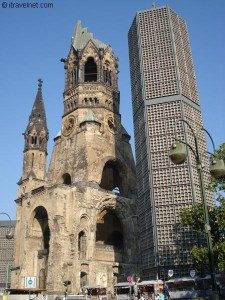If chapter four (“Marching on their Stomachs”) focused on the rationing, chapter two (“A Guarded Optimism”) highlighted the effects of the blackout upon the Berlin residents. It is interesting to see how both affected people’s morale but the rationing was immensily more effective (militarly speaking). The advent of radar technology made the blackouts innefective yet the government ensured on making it happen – despite the tactible increase in deaths as a result of the ensured darkness. It just seemed so far-fetched there was ever a time when pilots relied only on visual determination.
Kasier Wilhelm Memorial Church in West Berlin was preserved after a bombing in WWII
However, the most fascinating part is that despite the hardships of both government ensured policies, people’s morale was not as affected as during WWI. The number of casualties in battle was still significantly lower than the “Great War” and the rationing was not as strenuous as the “Turnip Winter” (1916-1917).

